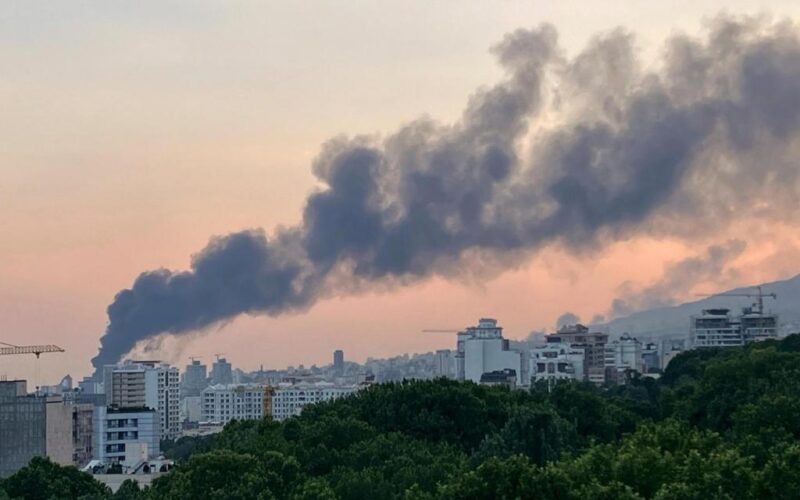By JOSEPH KRAUSS, JON GAMBRELL and JULIA FRANKEL
DUBAI, United Arab Emirates (AP) — Iran’s supreme leader on Wednesday rejected U.S. calls for surrender in the face of blistering Israeli strikes and warned that any military involvement by the Americans would cause “irreparable damage” to them, in recorded video aired by state TV.
It was the second public appearance by Ayatollah Ali Khamenei since the strikes began, and came a day after U.S. President Donald Trump demanded “UNCONDITIONAL SURRENDER” in a social media post and warned Khamenei that the U.S. knows where he is but has no plans to kill him, “at least not for now.”
Trump initially distanced himself from Israel’s surprise attack on Friday that triggered the conflict, but in recent days has hinted at greater American involvement, saying he wants something “much bigger” than a ceasefire. The U.S. has also sent more military aircraft and warships to the region.
‘The Iranian nation is not one to surrender’
Khamenei dismissed the “threatening and absurd statements” by Trump.
“Wise individuals who know Iran, its people, and its history never speak to this nation with the language of threats, because the Iranian nation is not one to surrender,” he said. “Americans should know that any military involvement by the U.S. will undoubtedly result in irreparable damage to them.”
A state TV anchor had read Khamenei’s statement earlier, before the video was aired. Iran followed a similar sequence in releasing an earlier statement from the supreme leader, perhaps as a security measure. His location is not known.
His voice echoed as he sat in a room with beige curtains. An Iranian flag and a portrait of Grand Ayatollah Ruhollah Khomeini, who Khamenei succeeded in 1989, hung behind him.
An Iranian official had earlier Wednesday warned that U.S. intervention would risk “all-out war.”
Foreign Ministry spokesman Esmail Baghaei did not elaborate, but thousands of American troops are based in nearby countries within range of Iran’s weapons. The U.S. has threatened a massive response to any attack.
Another Iranian official said the country would keep enriching uranium for peaceful purposes, apparently ruling out Trump’s demands that Iran give up its disputed nuclear program.
Strikes in and around Tehran
The latest Israeli strikes hit a facility used to make uranium centrifuges and another that made missile components, the Israeli military said. It said it had intercepted 10 missiles overnight as Iran’s retaliatory barrages diminish. The U.N. nuclear watchdog said Israel had struck two centrifuge production facilities in and near Tehran.
The Israeli military said it also carried out strikes in western Iran, hitting missile storage sites and a loaded missile launcher.
Israeli strikes have hit several nuclear and military sites, killing top generals and nuclear scientists. A Washington-based Iranian human rights group said at least 585 people, including 239 civilians, have been killed and more than 1,300 wounded.
Iran has fired some 400 missiles and hundreds of drones in retaliatory strikes that have killed at least 24 people in Israel and wounded hundreds. Some have hit apartment buildings in central Israel, causing heavy damage, and air raid sirens have repeatedly forced Israelis to run for shelter.
Iran has fired fewer missiles as the conflict has worn on. It has not explained the decline, but Israel has targeted launchers and other infrastructure related to the missiles.
Casualties mount in Iran
The Washington-based group Human Rights Activists said it had identified 239 of those killed in Israeli strikes as civilians and 126 as security personnel.
The group, which also provided detailed casualty figures during 2022 protests over the death of Mahsa Amini, crosschecks local reports against a network of sources it has developed in Iran.
Iran has not been publishing regular death tolls during the conflict and has minimized casualties in the past. Its last update, issued Monday, put the toll at 224 people killed and 1,277 others wounded.
Shops have been closed across Tehran, including in its famed Grand Bazaar, as people wait in gas lines and pack roads leading out of the city to escape the onslaught.
A major explosion could be heard around 5 a.m. in Tehran Wednesday morning, following other explosions earlier in the predawn darkness. Authorities in Iran offered no acknowledgement of the attacks, which has become increasingly common as the Israeli airstrikes have intensified.
At least one strike appeared to target Tehran’s eastern neighborhood of Hakimiyeh, where the paramilitary Revolutionary Guard has an academy.
Iran says it will keep enriching uranium
Israel says it launched the strikes to prevent Iran from building a nuclear weapon, after talks between the United States and Iran over a diplomatic resolution had made little visible progress over two months but were still ongoing. Trump has said Israel’s campaign came after a 60-day window he set for the talks.
Iran long has insisted its nuclear program was peaceful, though it is the only non-nuclear-armed state to enrich uranium up to 60%, a short, technical step away from weapons-grade levels of 90%. U.S. intelligence agencies have said they did not believe Iran was actively pursuing the bomb.
Israel is the only country in the Middle East with nuclear weapons but has never publicly acknowledged them.
Iran’s ambassador to Geneva, Ali Bahreini, told reporters that Iran “will continue to produce the enriched uranium as far as we need for peaceful purposes.”
He rejected any talk of a setback to Iran’s nuclear research and development from the Israeli strikes, saying, “Our scientists will continue their work.”
Israel welcomes first repatriation flights
Israelis began returning on flights for the first time since the country’s international airport shut down at the start of the conflict.
Two flights from Larnaca, Cyprus, landed at Tel Aviv’s Ben Gurion International Airport on Wednesday morning, said Lisa Dvir, an airport spokesperson.
Israel closed its airspace to commercial flights because of the ballistic missile attacks, leaving tens of thousands of Israelis stranded abroad. The conflict has disrupted flight patterns across the region.
Frankel reported from Jerusalem. Associated Press writers Amir Vahdat and Nasser Karimi in Iran, and Jamey Keaten in Geneva, contributed.
Originally Published:











